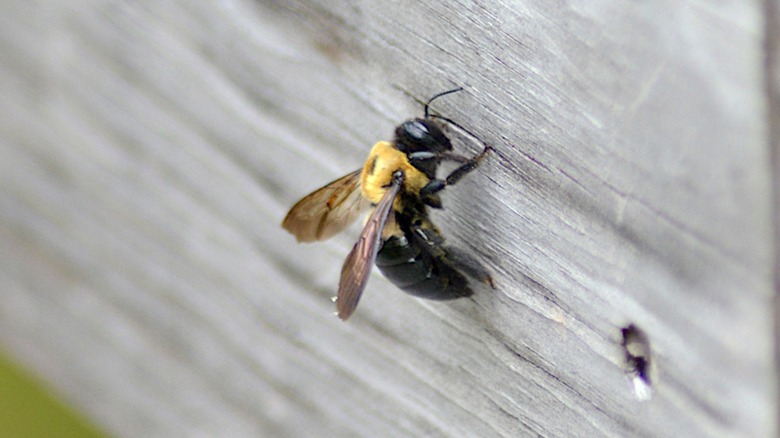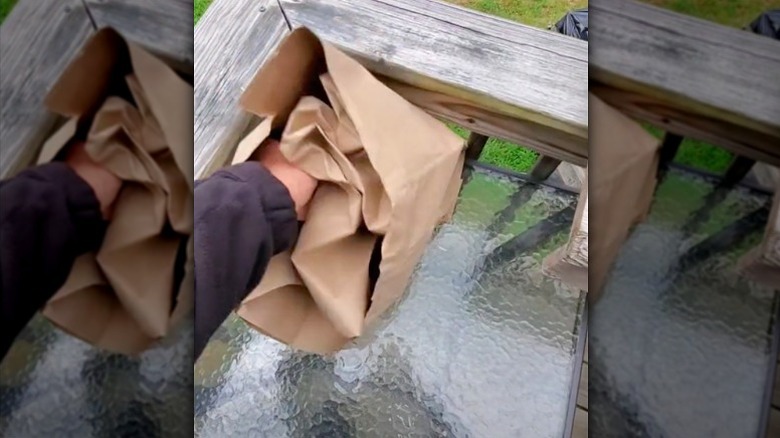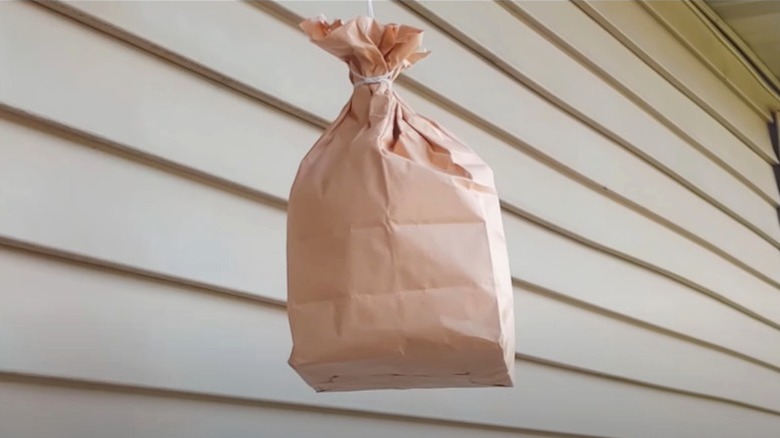The Simple Paper Bag Hack To Repel Carpenter Bees From Your Home
Despite their pollinating benefits in the garden, carpenter bees are rarely a pleasant sight when they stray too close to the house. It isn't the threat of a sting that gives them their pest status (or their descriptive name). Instead, the major issue with carpenter bees versus bumble bees and other varieties is their habit of boring into wood to build nests, a trait that becomes a hazard when it's directed toward your home's structures. Inviting pollinators to the yard is a worthwhile endeavour. But you have to match that with methods to repel carpenter bees responsibly and effectively. Interestingly enough, a key part of that effort may take nothing more than a brown paper bag.
The idea behind this simple hack is that a brown paper bag can double as a fake wasp nest. When you inflate it and hang it up outside the house, it creates a phony territorial threat. To avoid conflict, the carpenter bees will, theoretically, keep their distance. Though it may not be the most effective solution for established nests, many use this trick to make visiting bees think twice before shacking up in nearby wood structures. You can even buy phony wasp nests online, indicating some level of effectiveness for repelling stinging insects. Of course, something this easy is seldom a magic bullet. When dealing with carpenter bees, this paper bag hack is only one of many tactics to try, and the way you set it up could play a critical part in how well it actually works.
Using this paper bag hack to get rid of carpenter bees
Using a paper bag as a decoy wasp nest is one of the easiest and safest ways to get rid of carpenter bees for all involved. All you need are a brown paper bag (e.g., grocery bag) and some fill material to give it some bulk and keep it from blowing around in the wind. Fill the bag with plastic bags, bubble wrap, newspaper, and other leftover material you don't mind pitching later. To add some heft and keep it stable on windy days, place stones and other heavy materials in the bottom of the bag with the other fill. Twist the top of the bag closed, and tie it shut with string, cord, or rubber bands. Work in some creases around the bag to give it a more nest-like texture.
With the bag made, you can close and hang it. Find a sheltered spot where the bag won't immediately get destroyed by rainfall. Tie it to a hook with twine or cord, and you're good to go. Ideally, you should hang these early in the season. Female carpenter bees begin to nest around April or May, so putting up your decoys before then could make the bees encounter them before they decide to set up their new home. Hopefully, they'll recognize the area is spoken for and, rather than risk a fight, look for new places to nest
Is the paper bag hack effective at repelling wasps?
No matter how convincing you make your paper bag wasp nest, you should manage any expectations. Its effectiveness works on a spectrum. Some anecdotes say it works beautifully, others proclaim it doesn't do anything, and still more say it works for a few days before the bees get wise to the trick and realize it isn't a threat. After all, it may look the part, but there's no wasp scent in the decoy to repel carpenter bees. Plus, a lack of wasp activity can embolden the bees to explore it.
Does that mean you shouldn't bother with the brown bag hack? Not at all! Buying a wasp nest decoy can set you up for disappointment, but a DIY version is practically free and only takes a few seconds to whip up. There isn't much room for remorse if it doesn't work. Use it in an integrated strategy with other bee-friendly deterrents, like repairing and painting or staining your wood surfaces. Spreading almond or citrus oil on the wood might further dissuade carpenter bees in an eco-friendly, health-safe way, or you could try the sound of wind chimes to push them away.
Remember that carpenter bees are a valuable asset in the right places. We should treat them kindly whenever possible. While you can DIY your own carpenter bee trap, you could also try giving them sacrificial wood structures to use in the garden so they stay away from your home. With early action to prevent initial nesting, there's no reason you can't live harmoniously with these increasingly vital pollinators.


